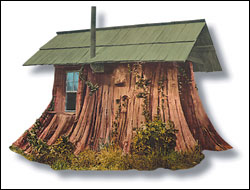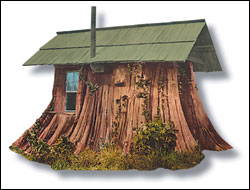I felt a little sorry for Carl Hultman. He was like the point guard for the Washington Generals, the basketball team that always lost to the Harlem Globetrotters. Their job was to lose after playing just hard enough to be an entertaining foil for the Globetrotters’ orb-handling genius. If the Generals actually put up a fight, the crowd would go home disappointed.
Hultman is a Pierce County deputy prosecuting attorney, and to him and a colleague, Mary Robnett, fell the unenviable task of defending the 19th century prosecution and conviction of Chief Leschi, the Nisqually tribal leader who played a key role in the Indian uprising of 1855–’56. Leschi was controversially hanged for murder in 1858 in what many believe amounted to a legal lynching.
The forum for this was a “Historical Court of Inquiry and Justice” that convened last Friday, Dec. 10, at the Washington State Historical Museum in Tacoma. (See Mossback, “Wrongheaded Murder,” Dec. 8.) It was an appropriate venue for several reasons. First, Pierce County is where the dirty deed took place. Second, the county has a long tradition of law-enforcement misconduct, ranging from sheriff’s office corruption to the bizarre case of David Brame, the Tacoma police chief who murdered his wife and took his own life in front of his children in 2003. Such gothic events could be evidence that forces in the county have been seeking karmic balance since the Leschi affair.
Which brings me to the third point about the venue. The museum is where our state tells its collective stories. And the Leschi historical court was less about the law than it was a chance to give the Leschi story a new ending.
It was clear from his closing arguments that Hultman wasn’t going to mount much of a case on behalf of the prosecution. Even he admitted he was speaking not from his heart but from his inner lawyer, which, presumably, has no heart. For hours, the lawyers for the petitioners who were seeking the exoneration of Leschi had called nearly a dozen witnesses—historians, military officers, tribal members, even Leschi’s descendents—to make the case that a miscarriage of justice had taken place. Their testimony was powerful and convincing.
They made it clear that no jury would likely find Leschi guilty today because there was too much “reasonable doubt.” On his worst day, Johnny Cochrane would have gotten the case laughed out of court. For example, the foreman of the grand jury that indicted Leschi was the chief witness against him, and his story kept changing. There was a good deal of doubt that Leschi was even at the scene of the crime, let alone that he pulled the trigger and brought down militia Col. A.B. Moses with a single shot in the back. To top it off, it seems clear that Leschi’s “crime” was an act of war committed during recognized hostilities between the Indians and the American government—sovereign entities. Indeed, when Leschi surrendered to the Army, he was promised amnesty. But the civilian authorities saw it differently and tried, convicted, and executed Leschi over military objections.
In fact, the military refused to allow the hanging on its property at Fort Steilacoom. Leschi was hanged nearby. Even his hangman said Leschi was probably innocent. As Nisqually fishing-rights leader Bill Frank Jr. testified at last week’s court, “I don’t think the Steilacoom people are proud to be part of that hanging.”
The injustice was further amplified by the moving words of historians and tribal members who testified to the importance of Leschi within the Indian community. He was a popular, strong leader among the Nisqually, eloquent and well respected by whites and Indians alike. He went to war to right the wrongs of a lousy treaty. It was also clear that the pain of his loss, and the injustice of the “white courts,” was a sore spot that had never healed. Dorian Sanchez, Nisqually tribal council chair, asked the court to “allow a leader and his people to rest knowing his war is finally over.”
The prosecution rarely cross-examined the witnesses and called none of its own. No descendants of A.B. Moses testified; no legal experts who could expound on 19th century territorial law; no historians who could testify to the conditions of terror that then existed at the lonely frontier outposts on Puget Sound. It’s a shame, really, because the historical dialogue could have been much richer, if more contentious. But this wasn’t a genuine adversarial game. Hultman’s main point for the prosecution was a technical one: We do not have enough information to second-guess the legal process; let the verdict stand.
But you don’t exhume a body unless you’re suspicious of something. If there wasn’t a compelling case for injustice, the Legislature would likely never have passed a resolution asking the state Supreme Court to review the case. Nor would the handpicked panel of seven top judges—led by Supreme Court Chief Justice Gerry Alexander—have wasted a day on the proceedings, let alone the hours planning it. Nor would the hundred-plus people in the audience, most of them Native Americans, have attended with such a palpable sense of anticipation of justice long denied.
After an afternoon of testimony, the judges retired to render their decision. They came back 20 minutes later with a unanimous one: Chief Leschi was a lawful combatant in a time of war and should never have been tried for murder. They gave him full exoneration.
So the Indian War is over for Chief Leschi and his people. They have a much better ending to their story, and we whites have a better one for ours, too. It was less a trial than a cleansing ceremony, one we all needed.







